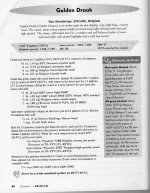Golds
Apprentice
Found two recipes for a Gulden Draak all-grain clone. Both grain bills very closely compare. Both are 5 gallon batches. Both have ABVs between 8.8% and 10.5%. Both have SRM of 22.
When I entered the grain bill, hops, and yeast into BeerSmith it estimates the ABV to be 4.9% and the SRM to be 11.9. The BeerSmith estimated OG and FB are also well below the recipe report.
Any suggestions why the BeerSmith readings are so much lower than the recipe report?
When I entered the grain bill, hops, and yeast into BeerSmith it estimates the ABV to be 4.9% and the SRM to be 11.9. The BeerSmith estimated OG and FB are also well below the recipe report.
Any suggestions why the BeerSmith readings are so much lower than the recipe report?

